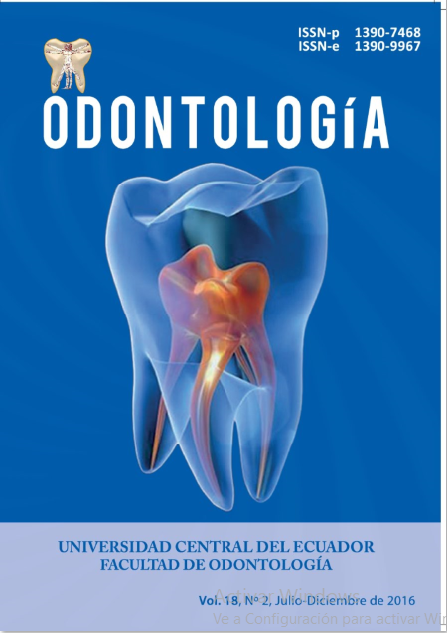Influence of the technique of ultrasonic preparation on the adaptation of fiberglass conical post
Keywords:
Endodontic, fiberglass post, preparation for intra-radicular retainerAbstract
Objective: Was to evaluate ex vivo the adaptation of conical fiber posts WhitePost DC 0,5 in circular canals prepared with the PostPrep 0.5 ultrasonic tip and WhitePost DC 0,5 drills. Materials and methods: 30 upper lateral incisors were used. The root canals were instrumented and apical filling. Subsequently, two experimental groups were randomly divided; Group 1 (15 roots): Post Preparation with PostPrep 0.5 ultrasonic tip and Group 2 (15 roots): prepared with WhitePost DC 0.5 drills. Conical fiberglass posts were cemented with resin cement. The roots were sectioned and cross sections were obtained from each root (Cervical third and apical third of the post). The cuts were observed with a Stereoscopic at 40x magnification. The adaptation of the post to the dentin walls could be measured, was evaluated the thickness of resinous cement and the area of the root canal occupied by the post. The statistical evaluation used the t-student and Mann-Whitney tests. Results: In the cervical thirds, a fine amount of dual resinous cement was obtained in both groups without difference between groups (p> .05) And a higher percentage of area occupied by the post in the root canal of 93.12% and 90.79% in both groups, and in the apical third of the post there was a smaller quantity of resinous cement for group 1 when com-pared with group 2 (p <.05), consequently a better adaptation of the post in the root canal. Likewise, the posts of group 1 presented a greater percentage of occupied area in the root canal 83.14% and 69.57% in group 2 with significant statistical difference between groups (p <0.5). Conclusions: In circular canals the ultrasonic preparation technique allowed a better adaptation of the conical fiberglass post in the canal, compared with rotary preparations.
Downloads
References
2. Dietschi D, Duc O, Krejci I, Sadan A. Biomechani-cal consideration for the restoration of endodontical-ly treated teeth: a systematic review of the literature. Part II Evaluation of fatigue behaviour, interfaces, and in vivo studies. Quintessence International. 2008, 39(2):117–29
3. Santos-Filho PC, Veríssimo C, Soares PV, Saltarelo RC, Soares CJ, Marcondes Martins LR. Influence of ferrule, post system, and length on biomechanical be-havior of endodontically treated anterior teeth. J En-dod. 2014 Jan;40(1): 119-23.
4. Schwartz RS, Robbins JW. Post placement and resto-ration of endodontically treated teeth: a literature re-view. J Endod. 2004;30(5): 289-301.
5. Coniglio I, Garcia-Godoy F, Magni E, Carvalho CA, Ferrari M. Resin cement thickness in oval-shaped ca-nals: oval vs. circular fiber posts in combination with different tips/ drills for post space preparation. Ameri-can Journal of Dentistry. 2009; 22 (5): 290–4.
6. Valdivia JE, Machado MEL. Blindaje corono-radicular simultáneo en endodoncia: de la instrumentación radi-cular a la restauración definitiva. Canal Abierto SECH. 2016; 34: 12-19.
7. Robbins JW. Guidelines for the restoration of endodon-tically treated teeth. J Am Dent Assoc. 1990; 120(5):558-566.
8. Lloyd PM, Palik JF. The philosophies of dowel diam-eter preparation: a literature review. J Prosthet Dent. 1993;69(1):32–6.
9. Coniglio I, Magni E, Cantoro A, Goracci C, Ferra-ri M. Push-out bond strength of circular and oval-shaped fiber posts. Clinical Oral Investigations 2011.15(5): 667–72.
10. Serafino C, Gallina G, Cumbo E, Ferrari M. Surface debris of canal walls after post space preparation in endodontically treated teeth: A scanning electron mi-croscopic study. Oral Surg Oral Med Oral Pathol Oral Radiol Endod. 2004; 97(3):381-387.
11. Ferrari M, Vichi A, Mannocci F, Masson PN. Retro-spective study of the clinical performance of fiber posts. Am J Dent 2000;13:9B–13.
12. Cagidiaco MC, Radovic I, Simonetti M, Tay F, Ferra-ri M. Clinical performance of fiber post restorations in endodontically treated teeth: 2-year results. Int J Prost-hodont. 2007; 20(3): 293–8.
13. Macedo VC, Faria ESAL, Marcondes Martins LR. Ef-fect of cement type, relining procedure, and length of cementation on pull-out bond strength of fiber posts. J Endod. 2010; 36(9):1543–6.
14. Manicardi CA, Versiani MA, Saquy PC, Pecora JD, de Sousa-Neto MD. Influence of filling materials on the bonding interface of thin-walled roots reinforced with resin and quartz fiber posts. J Endod. 2011;37(4):531–7.
15. Newman MP, Yaman P, Dennison J, Rafter M, Billy E. Fracture resistance of endodontically treated teeth re-stored with composite posts. J Prosthet Dent. 2003; 89 (4): 360-7.
16. Goracci C, Fabianelli A, Sadek FT, Papacchini F, Tay FR, Ferrari M. The contribution of friction to the dislo-cation resistance of bonded fiber posts. J Endod. 2005; 31(8):608-612.
17. D’Arcangelo C, Cinelli M, De Angelis F, D’Amario M. The effect of resin cement film thickness on the pullout strength of a fiber-reinforced post system. Journal of Prosthetic Dentistry. 2007; 98(3): 193–8.
18. Muñoz C, Llena C, Forner L. Oval fiber posts do not improve adaptation to oval-shaped canal walls. Journal of Endodontics. 2011; 37(10): 1386–9.
19. Grandini S, Goracci C, Monticelli F, Borracchini A, Ferrari M. SEM evaluation of the cement layer thickness after luting two different posts. The Journal of Ad hesive Dentistry. 2005; 7(3): 235–40.
20. Coniglio I, Carvalho CA, Magni E, Cantoro A, Ferrari M. Post space debridement in oval-shaped canals: the use of a new ultrasonic tip with oval section. J Endod. 2008; 34(6):752–755.
21. Boone KJ, Murchison DF, Schindler WG, Walker III WA. Post retention: the effect of sequence of post space preparation, cementation time, and different sealers. J Endod. 2001; 27(12):768-771.
22. Sadek FT, Goracci C, Monticelli F, Grandini S, Cury AH, Tay F, Ferrari M. Immediate and 24-hour evaluation of the interfacial strength of fiber posts. J Endod. 2006; 32(12):1174-1177.


